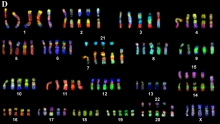Chromosome Number
Certainty styling is being phased out topic by topic.
Hover over keys for definitions:Humans have 23 pairs of chromosomes while great apes have 24 pairs. Human chromosome 2, a large metacentric chromosome, is the product of a fusion between two smaller telocentric chromosomes found in the other great apes. This fusion resulted in humans having one less chromosome pair than apes. Remnant sequences of telomeres can be identified at the fusion point in band 2q13. Remnants of the second (now inactive) centromere are present in bands 2q21.3 to 2q22.1.

Humans carry one fewer chromosome than chimpanzees, bonobos, gorillas and orangutans. The human difference is a derived feature.
The chromosome number is universally shared among humans.
The creation of human chromosome 2 involved fusion of two smaller telocentric chromosomes.
References
-
Case Report: Potential Speciation in Humans Involving Robertsonian Translocations., , Biomedical Research, Volume 24, Issue 1, p.171-174, (2013)
-
First Years of Human Chromosomes, , (2007)
-
The origin of man: a chromosomal pictorial legacy., , Science, 03/1982, Volume 215, Issue 4539, p.1525-30, (1982)

